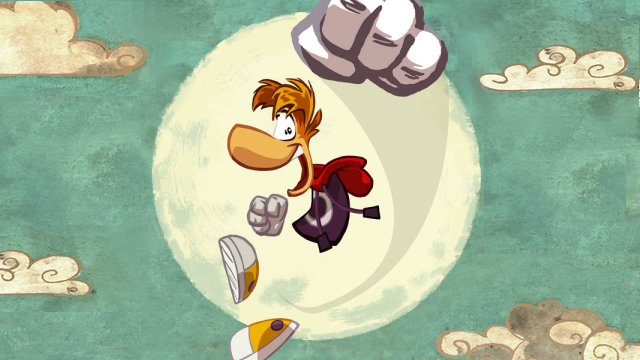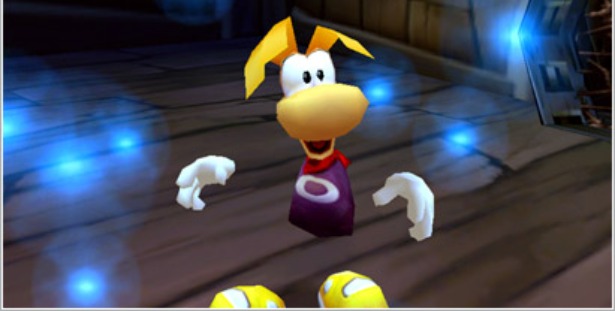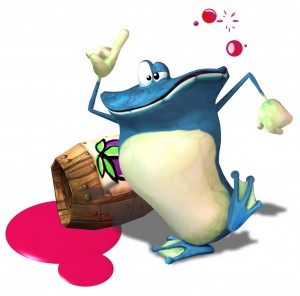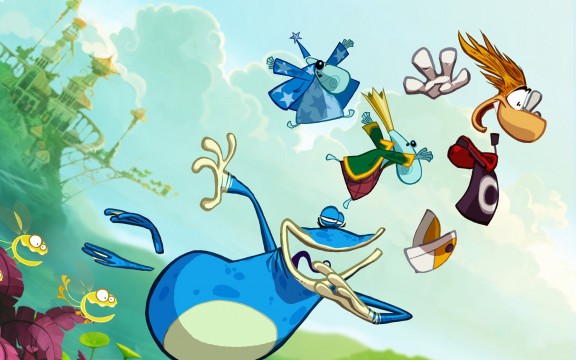
Picture the scene. It’s 1995. The 16-bit era is winding down, and Sony’s new PlayStation is just about to hit the market. The world of 3D gaming is just around the corner, but you have one small problem. A crazy kid called Michel Ancel has just come up to you and said he wants to create a new 2D platformer IP called Rayman, and you’ve decided to sink all your money into funding his project, desperately hoping it’s going to pay off. It sounded like a great plan on paper– the 2D platforming genre is still very much alive, after all, with SNES classics like Super Mario World, Super Metroid and Donkey Kong Country still fresh in gamers’ memories, but therein lies the rub. You see, it’s Nintendo producing all these great platformers, not this Ancel guy, and with Super Mario World 2: Yoshi’s Island due out only a month after Rayman‘s release, anyone else would say you’re completely insane for letting this guy take all your money.
Good thing, then, that the men in white coats were spared another victim, as Rayman was an absolute smash. People immediately fell in love with Rayman’s vibrant, cartoonish world and wacky sense of humour, and the music was absolutely gorgeous. It was so popular, in fact, that it went on to become the best-selling PlayStation game of all time in the United Kingdom, beating both Tomb Raider and Gran Turismo to the coveted top spot. As a result, a sequel was almost guaranteed, and four years later Rayman 2: The Great Escape arrived on Nintendo 64, with the PlayStation release following a year later.

The Great Escape was so popular that it got ported to both DS and 3DS.
Now that we were well and truly into the fifth generation of consoles by this point, The Great Escape finally brought the series into 3D, but did so with a much darker tone than its predecessor. The core gameplay was still the same– you were still collecting stuff and runnin’ and jumpin’ through a myriad of different worlds on your way to defeat evil– but The Great Escape introduced a gritty army of robot pirates into the fray who were out to pollute the Heart of the World and force it to the brink of destruction. Rayman’s lost all his powers from being stuck in prison, all his allies are in captivity, and everyone is pretty down in the dumps about the whole thing. That is, until Rayman’s faithful friend Globox (also captured) brings him a silver Lum from the fairy Ly to help him break out of the pirate’s stronghold.
 What follows is a beautifully orchestrated romp through the Glade of Dreams as Rayman tries to find four masks to get his powers back, but what really set The Great Escape apart was Ancel’s sense of whimsy and imagination. Rayman could not only use his hair as a helicopter, but he could also, quite literally, throw his punches due to his lack of arms, and there wasn’t one enemy or creature that wasn’t overflowing with charm and personality. The worlds themselves were relatively linear, but they were all full-blooded fantasy adventures that were arguably more refined than both Super Mario 64 and Banjo Kazooie put together, and it remains a firm fan favourite even today.
What follows is a beautifully orchestrated romp through the Glade of Dreams as Rayman tries to find four masks to get his powers back, but what really set The Great Escape apart was Ancel’s sense of whimsy and imagination. Rayman could not only use his hair as a helicopter, but he could also, quite literally, throw his punches due to his lack of arms, and there wasn’t one enemy or creature that wasn’t overflowing with charm and personality. The worlds themselves were relatively linear, but they were all full-blooded fantasy adventures that were arguably more refined than both Super Mario 64 and Banjo Kazooie put together, and it remains a firm fan favourite even today.
Sadly, it would be another four years and another console cycle before Rayman got his third outing, but with Ancel busy working on the critically acclaimed Beyond Good & Evil at this point, he ended up only had a supervisory role in the game’s development– and it certainly showed in the end product. Rayman 3: Hoodlum Havoc still released to relatively positive reviews on GameCube, but in an effort to spice up the gameplay, the development team added in Super Mario-style timed power-ups and placed a greater emphasis on combat. They also finally gave Rayman and co. proper voice actors, which was a very welcome improvement over the nonsense language they spoke in The Great Escape, but a dodgy targeting system and slightly repetitive objectives meant Hoodlum Havoc failed to reach the same popular appeal as its predecessor.

In Rayman Origins, Rayman could be joined by Globox, Teensies and a whole host of other co-op characters.
And for a time, it looked like Hoodlum Havoc would be the last gamers saw of Rayman, as his new Raving Rabbid chums quickly stole the show in 2006 when they helped launched Wii with Rayman Raving Rabbids. Despite boasting Rayman’s name, this mini-game compilation was very much all about its crazy rabbit captors, and while it still had the same crazy humour as previous Rayman titles, many felt its crass butt-jokes were a poor replacement for the limbless hero we’d all grown to know and love. As a result, fans kept hoping and praying that we might still see Rayman make a return to home consoles, but with Rabbid after Rabbid title kept being churned out every year, many started to believe that maybe he really had hung up his gloves and gone into retirement.
Fast forward to 2011, though, and the internet was awash with the cries and cheers of rejoicing gamers. Rayman was back in the fantastic Rayman Origins, making a return to his 2D sidescrolling days of yore while still managing to breathe a new lease of life into a somewhat stale genre. Gone were the gritty tones of The Great Escape and the power-ups of Hoodlum Havoc— they were yesterday’s news. Instead, this was pure, quintessential Rayman, and with the added option of co-op play, it was an absolute riot. It may have been trying to piggy-back on the success of New Super Mario Bros. Wii, but as anyone who’s played it will be able to attest, Rayman Origins is a game of unbridled joy coupled with a fiendish difficulty. It was definitely not for the amateur platformer, but that still didn’t stop it from being one of the finest games in the entire series.
So how do you follow on from such an all-time high? With Rayman Legends, of course! I previewed the game back at the beginning of October, and it’s safe to say that this Origins sequel has easily become my most anticipated launch Wii U title. It features the same top-notch level design as its predecessor as well as a shiny new art style, and it’s all rounded out by some truly innovative uses of the Wii U GamePad too. It’s sad news that it’s been delayed until next year, but here’s hoping it will only make it better.




 ShareThis
ShareThis






